| |
The scope and purpose of the web catalogue
|
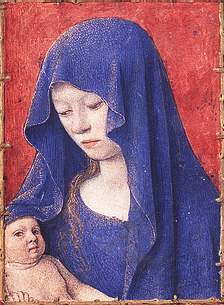
A web catalogue of a major collection of medieval illuminated manuscripts
must aim to serve many different masters. Just like a published catalogue,
it should provide information to anyone with a serious scholarly interest.
Like a public exhibition, however, it should also be interesting and pleasurable
to the occasional visitor, merely keen on finding pretty pictures.
Of course, we have tried to make the access to the underlying database
of medieval illumination as transparant as possible. Therefore, the
search screen will hold few surprises for those who are used to consulting
catalogues on medieval manuscripts. Even so, it may still be useful
for them to read at least part of this prologue. For those who have
no experience with manuscript catalogues or with medieval art in general,
these introductory paragraphs will certainly be useful, because we shall
show something of the richess of the material. We hope that the type
of information we describe here will stimulate you to explore the online
catalogue which you will reach when you click search.
For the moment the web catalogue is first of all committed to offering
a search facility for the collection. This emphasis on the database and
its access should not prevent you from browsing around. As a starting
point for browsing through the collection you could, for example, simply
select a Shelfmark from the first index on the search screen. It
is our intention to supplement the search facility of the catalogue with
a browse option which will give access to 'temporary exhibitions'
that focus on particular aspects of the collection.
|
|
Subject matters
We begin with a few notes on the iconographic retrieval facilities of
the catalogue, because the illumination is a focal point of the collection,
and because a great deal of time and effort has been invested in the subject
access to the miniatures, initials and border decorations. First of all,
captions have been written for every picture and an alphabetically arranged
list of these captions can be called forth by clicking on the index button
at the box Iconographic descriptions.At a later stage of the project
a complete list of the words used in the captions will be added to the
retrieval facilities.
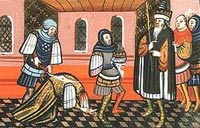  Secondly,
all pictures have been indexed with the help of the system for iconographic
classification Iconclass.General information about Iconclass
can be found at the
Iconclass website. More specific information about the way the Iconclass
system has been applied to these manuscripts and about a number of editorial
issues, can be found at the website
of the indexers. Secondly,
all pictures have been indexed with the help of the system for iconographic
classification Iconclass.General information about Iconclass
can be found at the
Iconclass website. More specific information about the way the Iconclass
system has been applied to these manuscripts and about a number of editorial
issues, can be found at the website
of the indexers.
As you will find out when you use the catalogue, the application of Iconclass
makes it possible to query the database in a very precise way. Should
you be drawn to the gothic detail, for example, you could query the database
for pictures showing the detached heads of victims of decapitation. This
would retrieve, among others, the scene from Maccabees, where the head
of Alexander Balas is cut off and offered to King Ptolemy IV (left), and
the famous martyrdom of St. Denis and his companions (right).
At the same time the hierarchical structure of Iconclass allows you to
make very broad thematic selections. Whether you are interested in representations
of stories from classical history or mythology, agricultural activities,
the signs of the Zodiac, or scenes from the life of Christ between the
Last Supper and the Crucifixion, they can all be easily extracted from
the database with the help of the concepts that are part of Iconclass.
Below we give a sample of the query results for the general Iconclass
concept 47I agriculture, cattle-breeding, horticulture,
flowerculture, etc.. On the left you see a picture of Ceres - goddess
of the 'cultivated earth' - sowing wheat, from a copy of l'épître
d'Othéa by Christine de Pisan. In the centre there are two
pictures of farmers from the so-called labours of the month cycle
of a calendar in a Book of Hours. On the right is an illustration from
Livy's Roman History, of the story of Spurius Maelius who provisions the
city of Rome with wheat during a famine.
|
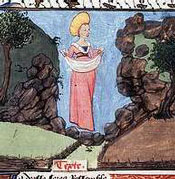
|
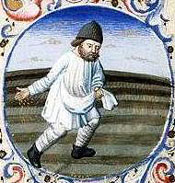
|
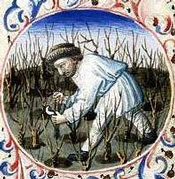
|
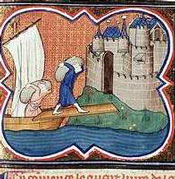
|
|
Chronology and geography
An important question about any historical document is of course: where
and when was it made? Obviously, then, places of origin and dates
of production have been made searchable. Since only a limited number of
manuscripts contain exact information about their year of production,
the option to search a date range - e.g. "all manuscripts made between
1250 and 1300" - is an important one and therefore included here.
The analysis of manuscripts to establish where they were made is, of course,
an ongoing scholarly effort. To stimulate that effort is one of the reasons
the collection is offered to the scholarly community in this way. Given
the limitations of the project and the scope of the collection, the names
of cities, regions, dioceses, convents, etcetera, could not be incorporated
in a hierarchy of historical geographical names. Only one top level broader
term could be included for each Place of origin. These broader
terms, which are best used to limit certain queries, are: France,
Northern Netherlands, Southern Netherlands, Italy,
Germany, Great Britain, and Spain. The geographical
division of the collection is not very surprising: about 90% of all manuscripts
can be divided in three large groups, attributable to the present Netherlands,
Belgium, and France. Of the remaining 10% or so, seventeen are Italian,
six are German, two English, and one is Spanish, recently acquired with
the financial support of the 'Friends of the Koninklijke Bibliotheek'.
|
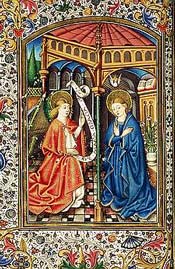
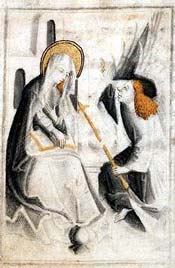 This
Spanish manuscript is a Book of Hours, made in Valencia around 1460.
Its illumination is attributed to 'followers of Juan Mari'. On the left
is shown the Annunciation scene, with which the Hours of the Virgin
begin. This
Spanish manuscript is a Book of Hours, made in Valencia around 1460.
Its illumination is attributed to 'followers of Juan Mari'. On the left
is shown the Annunciation scene, with which the Hours of the Virgin
begin.
On the right you see a grisaille with the same subject, this time
from a Delft Book of Hours, datable between 1440 and 1460 and attributed,
apt but not too original, to the so-called 'Masters of the Delft Grisailles'.
Here too, the Annunciation is the opening illustration of the Hours of
the Virgin.
Since the web catalogue also allows you to add the title of the text which
is accompanied by an illustration, to your query conditions, combined
searches for iconography, date, location, and text can be executed.
In this way you may discover, for instance, that out of forty six manuscripts
with the Hours of the Virgin with an illustration for the hour of Prime,
forty are illustrated with scenes from the Nativity cycle. Six of them,
however, are illustrated with a scene from the Passion, namely Christ
before Pilate. Half of these six originate in Utrecht, the other half
in the Southern Netherlands. Four of them are shown below.
|
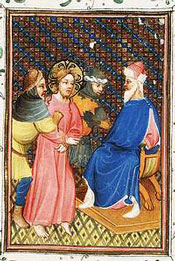 |
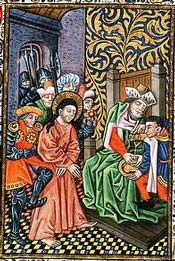 |
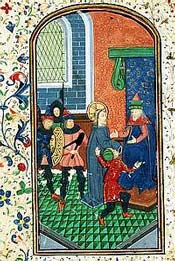 |
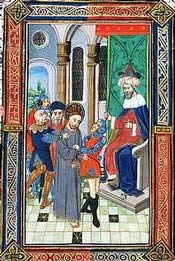 |
|
Utrecht, precursor of the Masters of Zweder van Culemborg, circa 1425
|
Utrecht, Master of the Boston City of God, circa 1470
|
Southern Netherlands, circa 1430-1450
|
Southern Netherlands, Willem Vrelant, circa 1460
|
|
Workshops and artists
Of the four miniatures of Christ before Pilate shown above, three
are attributed to a master. Only one of these is identified by a 'real'
name, Willem Vrelant. The others are identified with what is actually
a name for a set of stylistic characteristics. At 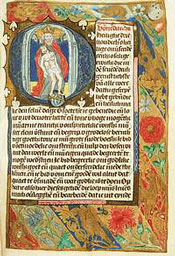  the time of writing over 1600 individual illuminations of the collection
have been attributed to 63 different stylistic groups and masters. Another
30 or 40 names of masters, workshops, etcetera, are still waiting to
be linked to specific miniatures, initials and border decorations. These
names can be selected from the indices on Miniaturist
the time of writing over 1600 individual illuminations of the collection
have been attributed to 63 different stylistic groups and masters. Another
30 or 40 names of masters, workshops, etcetera, are still waiting to
be linked to specific miniatures, initials and border decorations. These
names can be selected from the indices on Miniaturist
A limited number of the illuminated manuscripts of the Koninklijke Bibliotheek
carry the name of their scribe and an indication of their date of production.
Much rarer still, are manuscripts that carry their date of production
in combination with the name of their illuminator. On the left is a page
signed by Spierinck, and dated 1498. On the right you see the colophon
of a missal which says that Garnerus de Morolio wrote this manuscript
and Petrus de Raimbaucourt illuminated it 'illuminavit istum librum'.
They did this in 1323 for Johannes de Marchello, abbot of the Premonstratensian
abby of St. Jean in Amiens.
|
|
Nobles and antiquarians: the provenance
of the collection
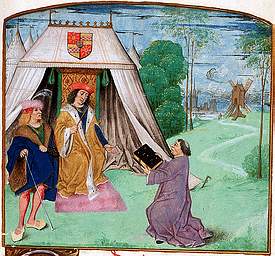 Scribes
and the occasional illuminator are not the only ones to have left behind
evidence of their activity and presence in manuscripts. Owners did so
too, by marking their possessions in various ways. The simplest way
to do this would be, like you would do today, to write your name on
a fly-leaf. A much more elaborate way would be to have your portrait
painted in the book. Thus you could document your role as a patron.
Such a portrait is shown on the left, where Augustin Molinet offers
his prose translation of the Roman de la Rose to Philip of Cleves.
Notice the little mill in the background, a visual pun on Molinet's
name. Scribes
and the occasional illuminator are not the only ones to have left behind
evidence of their activity and presence in manuscripts. Owners did so
too, by marking their possessions in various ways. The simplest way
to do this would be, like you would do today, to write your name on
a fly-leaf. A much more elaborate way would be to have your portrait
painted in the book. Thus you could document your role as a patron.
Such a portrait is shown on the left, where Augustin Molinet offers
his prose translation of the Roman de la Rose to Philip of Cleves.
Notice the little mill in the background, a visual pun on Molinet's
name.
 Like
other bibliophiles, Philip also had his coat of arms added to existing
manuscripts, e.g. to the copy of Livy's Roman History, which
entered Philip's library via his wife Françoise de Luxembourg,
and of which a fragment is shown on the right. Like
other bibliophiles, Philip also had his coat of arms added to existing
manuscripts, e.g. to the copy of Livy's Roman History, which
entered Philip's library via his wife Françoise de Luxembourg,
and of which a fragment is shown on the right.
|
|
 With
Philip of Cleves (1456-1528) we have mentioned a source of one of the
core collections of the Koninklijke Bibliotheek, and the collection
that would give it with its name, i.e. the collection of the stadholders,
forefathers of the royal family of the Netherlands. With
Philip of Cleves (1456-1528) we have mentioned a source of one of the
core collections of the Koninklijke Bibliotheek, and the collection
that would give it with its name, i.e. the collection of the stadholders,
forefathers of the royal family of the Netherlands.
Inevitably, the history of how the circa 330 illuminated manuscripts
that are presented here, came to rest in the Koninklijke Bibliotheek
is a chequered one, as you can see when you consult the index of Former
owners or institutions. The story of the stadholders' collection
is only a chapter in it. Another substantial chapter has to do with
a large group of manuscripts added to the Library's collection in 1823
by king William I. This group of 168 manuscripts had been part of the
rich art collection of the eccentric Belgian nobleman J.D. Lupus. The
king had paid 20,000 guilders for it, shortly after 1817. Although 20,000
guilders was a substantial sum, the king struck a very good deal if
we take into account that some 20% of all miniatures, initials and border
decoration in the web catalogue are from the Lupus collection. On the
right you see an opening from one of the manuscripts from the Lupus
collection, not selected because of its quality, but because it bears
curious marks - 17th-or 18th-century painted borders - of the usage
by one of its later owners, that gives yet another meaning to the term
'amateur'.
|

Limitations
This prologue to the web catalogue should of course also warn you about
its limitations. In other words, it should inform you about some of
the things you will not find here, at least not at this moment.
The emphasis of the catalogue is, to put it somewhat paradoxically,
on book illumination, not on illuminated books. Obviously, information
is made available about the manuscripts themselves, as is evident when
you look at the left half of the query screen. But none of the manuscripts
has been photographed in full, e.g. to offer a full electronic facsimile
of its text. Codicological and palaeographical idiosyncracies fell outside
the scope of the project. The pen-drawn decoration - an important tool,
especially for the location of manuscripts from the Northern Netherlands
- could at present not been given the attention it deserves. The information
supplied about bindings could not at this time be supported with visual
material.
As has been said above, information about the choices that had to be
made regarding the subject access to the pictures, can be found on the
website of the indexers. Here we limit ourselves to showing two of the
marginal illustrations that could not, given the present limitations,
be included in the iconographical information of this web catalogue.
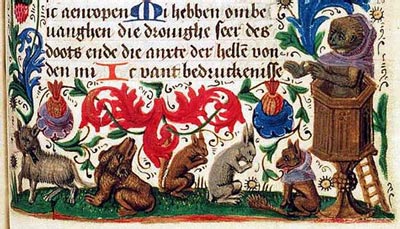
|
|
|

